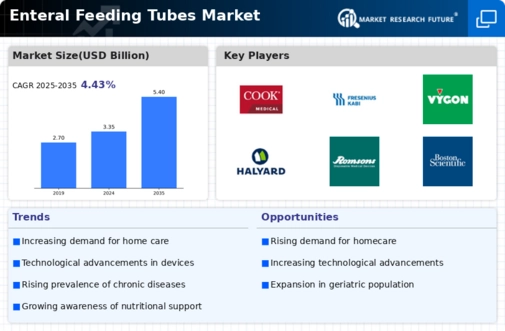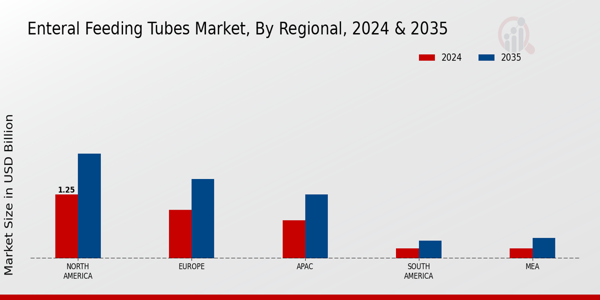Aging Population
The demographic shift towards an aging population significantly influences the Global Enteral Feeding Tubes Market Industry. As individuals age, they often face various health challenges that may impair their ability to consume food orally. According to the United Nations, the number of people aged 60 years and older is expected to reach 2.1 billion by 2050. This demographic is more likely to require enteral nutrition, thereby increasing the demand for enteral feeding tubes. The growing elderly population is likely to drive market growth as healthcare systems adapt to meet their nutritional needs.
Market Growth Projections
The Global Enteral Feeding Tubes Market Industry is projected to witness substantial growth over the coming years. With a market value anticipated to reach 3.35 USD Billion in 2024, the industry is expected to expand significantly, potentially achieving a valuation of 5.4 USD Billion by 2035. This growth trajectory suggests a compound annual growth rate of 4.44% from 2025 to 2035. Such projections indicate a robust demand for enteral feeding tubes, driven by various factors including technological advancements, an aging population, and increased healthcare expenditure.
Technological Advancements
Technological innovations in the design and functionality of enteral feeding tubes are propelling the Global Enteral Feeding Tubes Market Industry forward. Recent advancements include the development of more biocompatible materials and improved tube designs that enhance patient comfort and reduce complications. For example, the introduction of anti-kink and anti-clog features in feeding tubes has improved their usability. These innovations not only enhance patient outcomes but also expand the market by attracting healthcare providers seeking effective solutions for enteral nutrition.
Rising Healthcare Expenditure
The Global Enteral Feeding Tubes Market Industry is benefiting from the rising healthcare expenditure observed globally. Governments and private sectors are investing more in healthcare infrastructure, which includes the provision of enteral nutrition solutions. Increased funding for hospitals and healthcare facilities allows for the procurement of advanced enteral feeding tubes, thereby enhancing patient care. This trend is expected to contribute to a compound annual growth rate of 4.44% from 2025 to 2035, reflecting the growing recognition of the importance of nutritional support in patient recovery.
Increased Awareness and Education
Growing awareness regarding the importance of enteral nutrition is a key driver for the Global Enteral Feeding Tubes Market Industry. Healthcare professionals are increasingly educated about the benefits of enteral feeding, leading to more frequent recommendations for enteral nutrition in clinical settings. Initiatives by health organizations to promote enteral feeding as a viable option for patients unable to eat orally are contributing to this trend. As awareness increases, the market is projected to grow, with estimates suggesting a market value of 3.35 USD Billion in 2024, potentially reaching 5.4 USD Billion by 2035.
Rising Prevalence of Chronic Diseases
The Global Enteral Feeding Tubes Market Industry is experiencing growth due to the increasing prevalence of chronic diseases such as cancer, diabetes, and neurological disorders. These conditions often necessitate nutritional support through enteral feeding, driving demand for enteral feeding tubes. For instance, the World Health Organization indicates that the global burden of chronic diseases is rising, with projections suggesting that by 2030, chronic diseases will account for 75 percent of all deaths worldwide. This trend underscores the need for effective nutritional interventions, thus bolstering the market for enteral feeding tubes.





















Leave a Comment